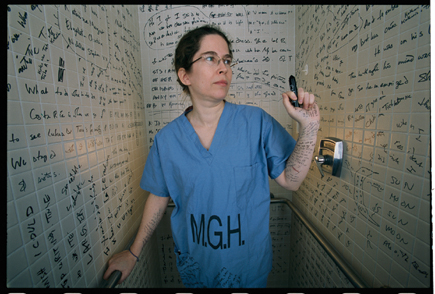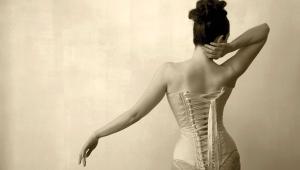Picturing Concepts; The Photography Of Cary Wolinsky Page 2
"I thought this would be cool--I would try to do it in English.
I set out to design a rebus, a work of art that would translate into words,
and to come up with a sentence in English that could be read the way a hieroglyphic
panel would be read, to make a sentence out of pictures."
The "mind" story took Wolinsky even further into the realm of illustration.
"The mind is what the brain does," he explains, "and eventually
my writer and I were able to photograph a brain surgery in Harbor-UCLA Medical
Center. It was an amazing event. Of all the landscapes I have ever seen in my
life, that operating room where they were doing the surgery was the most surreal.
The surgeon, I remember, had to stand on two milk crates in order to perform
the surgery."
As Wolinsky related his adventures, the photographers were particularly interested
in his research as well as the workflow. How does he settle on an idea and how
does the final image evolve?
Brain Surgery CT Scans |
|
 |
|
|
"Each journey requires massive amounts of research and the challenge
is always to make a picture that conveys something," Wolinsky says.
He explained that he relies heavily on his "fixers" in different
parts of the world. He has regulars in places like London and Japan with whom
he has worked for years. "I tell them, here's the shot I have in
mind. Make all the contacts and find people who are willing to participate and
if they agree, find out if there are any restrictions. We get all those things
cleared and when I arrive I usually have a truck and a driver in place to begin
with. It is important to have someone working on the ground for you."
In answer to how one located a "fixer" in different places in the
world where you are about to travel, Wolinsky's advice was to ask other
photographers.
"I am a fanatic researcher," he admits. "I may just start
out with one thing that interests me or catches my eye. Usually I am taking
notes, getting my ideas for a story, and then finding the actual text for that
story. My question is always: what is this basic story about? I list examples
of pictures I intend to take and often go over my ideas with an editor. On a
recent issue on the subject of poison, I gave National Geographic almost 10
examples of what I would photograph. When all arrangements are satisfactory
I research down to a shooting outline, make a grid and break it up by the general
concept. Finally, I make a sort of status list as to how far along I am and
wonder if I'm ever going to get out into the field and start shooting.
Hypergraphia |
|
 |
|
|
"Once I am past the proposal stage I then translate my ideas into a
project. How many countries? How much time in each country? My expenses? I try
to get everything prepared so I gang things into a trip. The problem is the
domino effect--if anything goes wrong early on, it starts to spill over
and my schedule becomes chaos."
Wolinsky has decided to curb his travels and has recently completed a unique
and magnificent studio just steps from his home in southern Massachusetts, where
he is currently working on an assignment for the National History Museum of
the Adirondacks, creating an image to be used on posters.
One photographer asked, "How much is the idea and how much is the photograph?"
"A unique idea certainly plays a big role," he answered, "but
how you get the story across comes down to getting good at what you do. Pictures
and words must work together. Pictures drive the entire process but you still
need to do the research. There's a story to tell and that's the
most important thing."
To learn more about Wolinsky, visit his website at: www.carywolinsky.com.
- Log in or register to post comments

















































